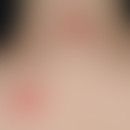Synonym(s)
epidermal nevus syndrome; Epidermal nevus syndrome Solomon; Flintstone Mims Syndrome; HAHH Syndrome; Linear verrucous epidermal naevus; Mould Penny Syndrome; Naevus sebaceus Jadassohn; Neuroectodermal syndrome; Skin-Eye-Brain-Heart Syndrome; Skin-eye-brain syndromes; Solomon Syndrome; Syndrome of the linear sebaceous nevus
HistoryThis section has been translated automatically.
Jadassohn, 1895; Schimmelpenning, 1957; Feuerstein and Mims, 1962
DefinitionThis section has been translated automatically.
Neuroectodermal symptom complex with nevus sebaceus, malformations and dysplasias of the eyes, skin, brain, skeleton and heart. The syndrome is often combined with hypophosphatemia.
You might also be interested in
EtiopathogenesisThis section has been translated automatically.
An early embryonic somatic mutation in the HRAS and KRAS genes (see also RAS) can be detected
ManifestationThis section has been translated automatically.
Congenital. Mostly only pronounced on one half of the body.
ClinicThis section has been translated automatically.
- The skin changes are present at birth and are the most striking and primary feature of this syndrome. Mostly multiple, predominantly linear naevi sebacei on the whole integument with preference of head and neck, also the oral mucosa may be affected.
- In the course of life multiple melanocytic nevi occur. Eye changes ( dermoid cyst, coloboma, corneal clouding, symblepharon) and cerebral symptoms (cranial asymmetry, cerebral seizures, often mental retardation) may be present. Further malformations are described. Different degrees of severity of all symptoms. Cases with hypophosphatemia of unexplained aetiology are known from the literature. In these cases, fractures, bone deformities, muscle weakness and pain occurred repeatedly.
LaboratoryThis section has been translated automatically.
Calcium, phosphate and alkaline phosphatase in serum. Phophate in urine.
Complication(s)(associated diseasesThis section has been translated automatically.
Hypophosphatemia! Clarification required!
TherapyThis section has been translated automatically.
- Excision of the naevi sebacei, as there is a risk of developing cutaneous tumours such as basal cell carcinomas, spinocellular carcinomas. Cooperation with ophthalmologists and neurologists, among others.
- In hypophosphatemia, substitution with phosphates and vitamin D.
LiteratureThis section has been translated automatically.
- Busch S, Altmeyer P (1994) Mold-penning flint mims syndrome (SFM syndrome). dermatologist 45: 719-721
- Flint RC, Mims LC (1962) Linar nevus sebaceous with convulsion and mental retardation. On J Dis Child 104: 675-679
- Jadassohn J (1895) Remarks on the histology of systematized naevi and on "sebaceous gland naevi". Arch dermatol syphilis 88: 355-394
- Schimmelpenning GW (1957) Clinical contribution to the symptomatology of phacomatoses. RöFo - progress in the field of X-rays and new imaging techniques (Hamburg) 87: 716-720
- Schworm HD et al (1996) Discordant monozygotic twins with the Schimmelpenning flint mims syndrome. Clin Genet 50: 393-397
- Warnke PH et al (2003) The sebaceous nevus as part of the mold penning flint mimsy syndrome - an obvious phacomatosis first documented in 1927 J Cutan Pathol 30: 470-472
- Zutt M et al (2003) Mold-penning flint mims syndrome with hypophosphatemic rickets. Dermatology 207: 72-76
Incoming links (20)
Child syndrome; Epidermal nevus syndrome; Epidermal nevus syndrome solomon; Eye diseases, skin changes; Goldenhar syndrome; Hahh syndrome; Hras; Incontinentia pigmenti (Bloch-Sulzberger); Linear verrucous epidermal naevus; Mosaik-RASopathies; ... Show allOutgoing links (11)
Basal cell carcinoma (overview); Corneal clouding; Dermoid cyst; Excision; Hras; Kras; Nevus melanocytic (overview); Nevus sebaceus; Ras Gene; Squamous cell carcinoma of the skin; ... Show allDisclaimer
Please ask your physician for a reliable diagnosis. This website is only meant as a reference.




